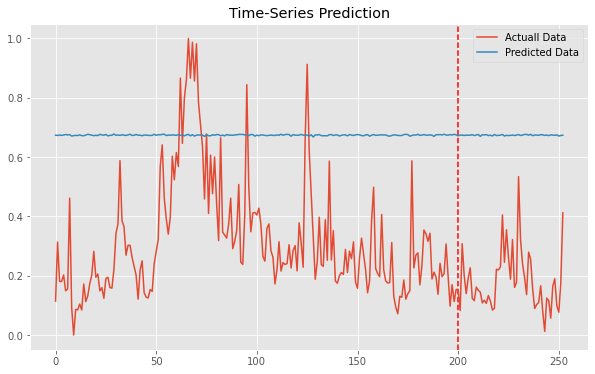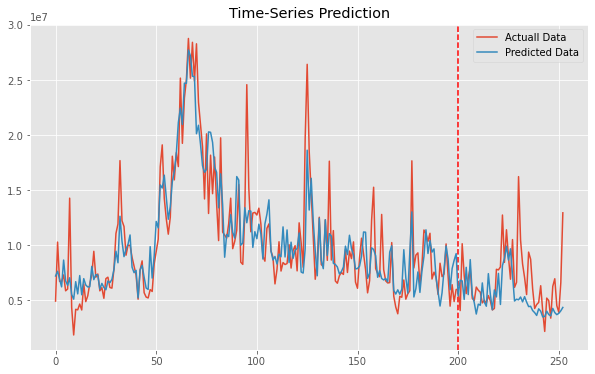Dear Pyro Community,
I tried to model a Bayesian LSTM model in pyro. At this stage it is only one LSTM leyer and two linear leyer to connecte to the output. I did the same example for pytorch lstm ato make sure that the code run uscessfully with good result. Now when I tried to chnage the code to pyro for bayesian estimations and giving priors to weights for both LSTM modul and Linear Modul, I see that after trainig the model, my prediction is almots Stationary and at does not follow any trend!, howvere the traditional LSTM in pytorch give at least goo trend. I will appreciate if anyonw give me insight how i can find the issue and how make the model better for Bayesian LSTM prediction. This would help other resercahers asw elll as I investigate a lot but coulkd bot find previous solved example for Bayeisna LSTM yet.
Here is my code:
class Model(PyroModule):
def init(self, input_size=1, num_classes=1, hidden_size=3, num_layers=1, prior_scale=50.0):
super().init()
self.num_classes = num_classes
self.num_layers = num_layers
self.input_size = input_size
self.hidden_size = hidden_size
self.activation = nn.ReLU() # or nn.ReLU()
# Correctly initialize the LSTM layer with bidirectional=False
self.lstm = PyroModule[nn.LSTM](input_size, hidden_size, num_layers, batch_first=True, bidirectional=False)
self.linear = PyroModule[nn.Linear](hidden_size, 128) # Adjusted for unidirectional LSTM
self.fc = PyroModule[nn.Linear](128, num_classes)
# Initialize weights and biases for each layer
# Input to hidden layer
self.lstm.weight_ih_l0 = PyroSample(dist.Normal(0., prior_scale).expand([4*hidden_size, input_size]).to_event(2))
self.lstm.bias_ih_l0 = PyroSample(dist.Normal(0., prior_scale).expand([4*hidden_size]).to_event(1))
# Hidden to hidden layer
self.lstm.weight_hh_l0 = PyroSample(dist.Normal(0., prior_scale).expand([4*hidden_size, hidden_size]).to_event(2))
self.lstm.bias_hh_l0= PyroSample(dist.Normal(0., prior_scale).expand([4*hidden_size]).to_event(1))
self.linear.weight = PyroSample(dist.Normal(0., prior_scale).expand([128,hidden_size]).to_event(2))
self.linear.bias = PyroSample(dist.Normal(0., prior_scale).expand([128]).to_event(1))
self.fc.weight = PyroSample(dist.Normal(0., prior_scale).expand([num_classes, 128]).to_event(2))
self.fc.bias = PyroSample(dist.Normal(0., prior_scale).expand([num_classes]).to_event(1))
def forward(self, x, y=None,noise_shape = 0.5):
h_0 = Variable(torch.zeros(self.num_layers, x.size(0), self.hidden_size)) #hidden state
c_0 = Variable(torch.zeros(self.num_layers, x.size(0), self.hidden_size)) #internal state
output, (hn, cn) = self.lstm(x, (h_0, c_0)) #lstm with input, hidden, and internal state
hn = hn.view(-1, self.hidden_size) #reshaping the data for Dense layer next
out = self.activation(hn)
out = self.linear(out)
out = self.activation(out)
mu = self.fc(out)
sigma = pyro.sample("sigma", dist.Gamma(noise_shape, 1)) # infer the response noise
with pyro.plate("data", x.shape[0]):
obs = pyro.sample("obs", dist.Normal(mu, sigma * sigma), obs=y)
return mu
and this the setps for MCMC training
Initialize the Bayesian LSTM model
input_size = X_test_tensors_final.shape[2] # Number of features
hidden_size = 2 # Number of features in hidden state
num_layers = 1 # Number of stacked LSTM layers
model = Model(input_size = input_size, num_classes =1, hidden_size = hidden_size, num_layers = num_layers, prior_scale=50.0)
Set up the MCMC sampler
nuts_kernel = NUTS(model)
mcmc = MCMC(nuts_kernel, num_samples=50, warmup_steps=50)
Run the MCMC sampler
mcmc.run(X_train_tensors_final, y_train_tensors)
here is also the plot i get for some data for this model training:

and this the result that i got for Pytorch LSTM

i used open data here to check the models